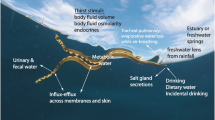Water is a demanding medium for vertebrate life (see Pough et al., 1990; Helfman et al., 1997). Per unit volume, water holds only about one twentieth as much oxygen as air and biological and chemical processes may reduce this further. Warm water contains less oxygen than cool water and as the salt content of water increases the solubility of oxygen decreases. Reduced availability of oxygen is potentially limiting for active animals like fishes. Swimming is also energetically expensive since water is 830 times denser than air and 80 times more viscous. As depth increases so does pressure, while light intensity decreases rapidly with depth and the quality of light changes. Nevertheless, fishes not only cope with these physical changes and constraints but also dominate aquatic habitats on the planet. In the open ocean, fishes are some of the fastest swimming organisms and others have colonised the dark ocean depths, turbulent waters on wave-swept rocky shores, the icy waters of the poles and freshwater lakes and rivers. Although freshwater environments hold a mere 0.01% of all the water on Earth, and lakes and rivers have short histories on a geological time scale, nearly one third of all teleosts (bony fishes; see Appendix 1) live in fresh water. In 1998, Eschmeyer recognised 23,250 fish species as valid and that about 200 new species are added to this list each year. He estimated that the number of valid fish species could reach 30,000 or 35,000 as poorly sampled geographic areas are studied. The contribution of the different kinds of fishes to this enormous number of species is however strongly asymmetrical. Approximately 96% of fishes are teleosts (see Appendix 1). The elasmobranchs (sharks and rays) are the next most diverse group, but their contribution to the total is a modest 3%. This leaves a few modern survivors of once diverse groups with ancient origins, such as the agnathans (strictly speaking these are not fishes; see p. 318), holocephalans, coelacanths, lungfishes and sturgeons. Teleosts are therefore the predominant fishes worldwide, excelling in numbers of species, sheer numbers of individuals and in the range of habitats that they occupy. Among the invertebrates, the cephalopod molluscs (squid and cuttlefish) have many fish-like features, but as Marshall (1971) pointed out, their distribution is limited to seawater by their kidney function and to well-oxygenated environments by limitations in the oxygen-carrying capacity of haemocyanin in their blood. This remarkable diversity and success of fishes is matched by their parasites, but in order to understand the challenge to potential fish parasites posed by their hosts we need to know more about this host diversity and about the anatomy and physiology of fishes.
Access this chapter
Tax calculation will be finalised at checkout
Purchases are for personal use only
Preview
Unable to display preview. Download preview PDF.
Similar content being viewed by others
Rights and permissions
Copyright information
© 2004 Springer
About this chapter
Cite this chapter
(2004). The hosts. In: Leeches, Lice and Lampreys. Springer, Dordrecht. https://doi.org/10.1007/978-1-4020-2926-4_1
Download citation
DOI: https://doi.org/10.1007/978-1-4020-2926-4_1
Publisher Name: Springer, Dordrecht
Print ISBN: 978-1-4020-2925-7
Online ISBN: 978-1-4020-2926-4
eBook Packages: Springer Book Archive




